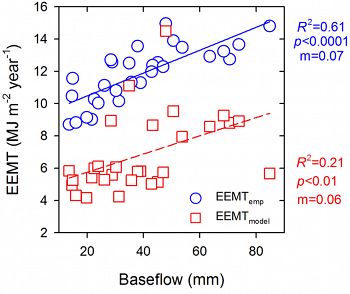Zapata-Rios et al., 2016
Influence of climate variability on water partitioning and effective energy and mass transfer in a semi-arid critical zone
Zapata-Rios X., Brooks P.D., Troch P.A., McIntosh J., and Rasmussen C. (2016)
Hydrology and Earth System Sciences 20: 1103-1115
-
Catalina-Jemez, GRAD STUDENT
-
Catalina-Jemez, INVESTIGATOR
-
Catalina-Jemez, INVESTIGATOR
-
Catalina-Jemez, INVESTIGATOR
-
Catalina-Jemez, INVESTIGATOR
Abstract
Relationship between water availability and EEMT. Base-flow and EEMT showed a positive linear correlation. As water availability in the JRB decreases, indicated by baseflow, EEMT also decreases
The critical zone (CZ) is the heterogeneous, near-surface layer of the planet that regulates life-sustaining resources. Previous research has demonstrated that a quantification of the influxes of effective energy and mass transfer (EEMT) to the CZ can predict its structure and function. In this study, we quantify how climate variability in the last 3 decades (1984–2012) has affected water availability and the temporal trends in EEMT. This study takes place in the 1200 km2 upper Jemez River basin in northern New Mexico. The analysis of climate, water availability, and EEMT was based on records from two high-elevation SNOTEL stations, PRISM data, catchment-scale discharge, and satellite-derived net primary productivity (MODIS). Results from this study indicated a decreasing trend in water availability, a reduction in forest productivity (4 g C m−2 per 10 mm of reduction in precipitation), and decreasing EEMT (1.2–1.3 MJ m2 decade−1). Although we do not know the timescales of CZ change, these results suggest an upward migration of CZ/ecosystem structure on the order of 100 m decade−1, and that decadal-scale differences in EEMT are similar to the differences between convergent/hydrologically subsidized and planar/divergent landscapes, which have been shown to be very different in vegetation and CZ structure.
Citation
Zapata-Rios X., Brooks P.D., Troch P.A., McIntosh J., and Rasmussen C. (2016): Influence of climate variability on water partitioning and effective energy and mass transfer in a semi-arid critical zone. Hydrology and Earth System Sciences 20: 1103-1115. DOI: 10.5194/hess-20-1103-2016
 This Paper/Book acknowledges NSF CZO grant support.
This Paper/Book acknowledges NSF CZO grant support.
Explore Further






